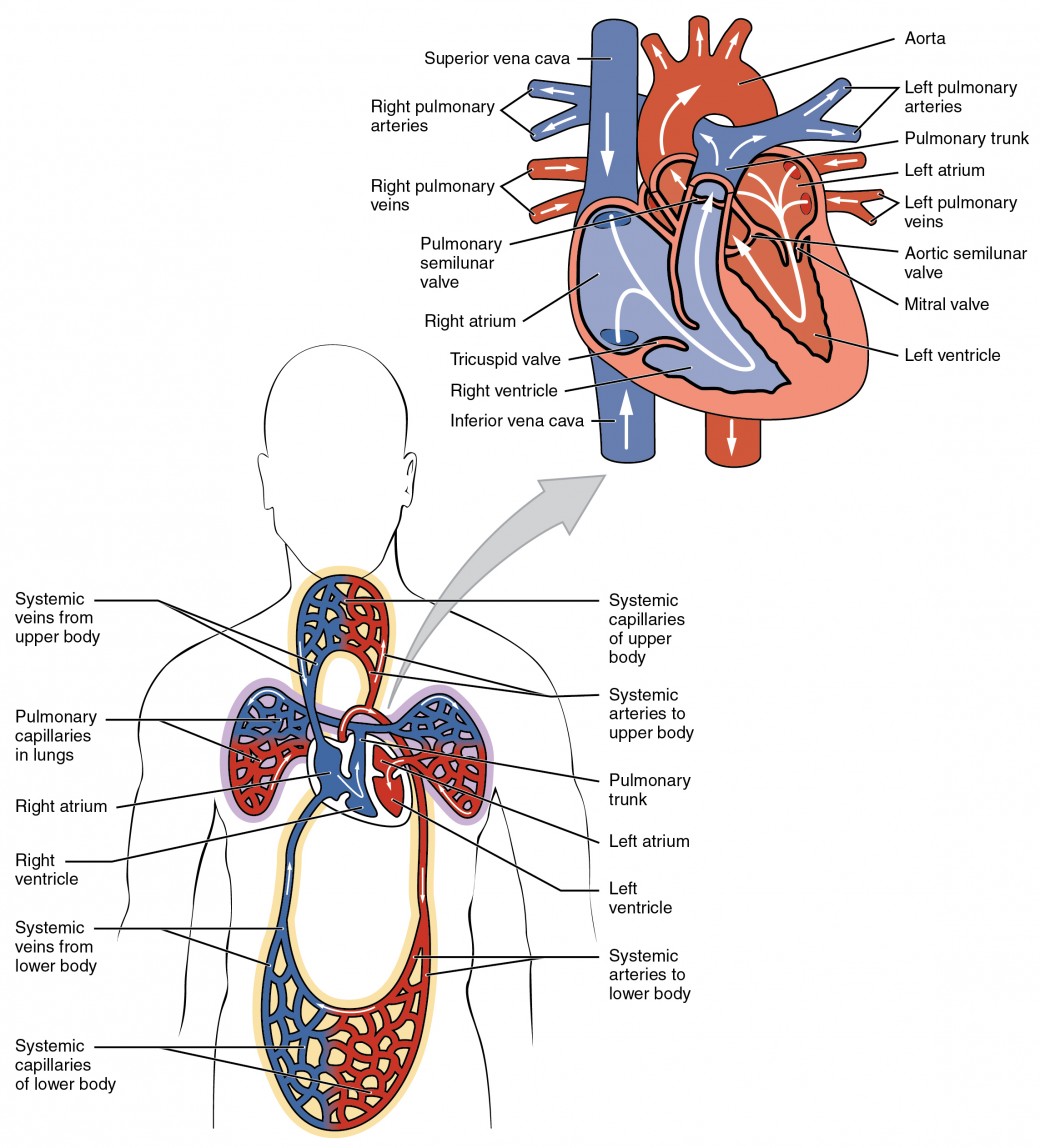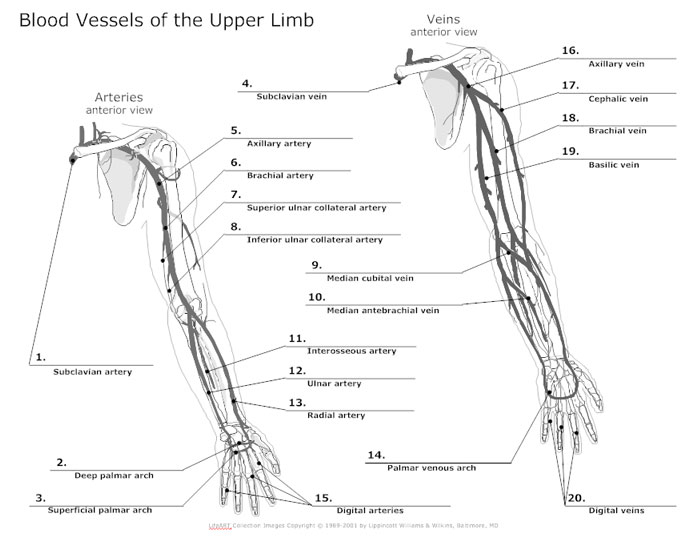Major Blood Vessel Chart | Blood is oxygenated in capillaries that flow through the alveoli of the lungs. Blood vessels are the body's highways that allow blood to flow quickly and efficiently from the heart to every region of the body and back again. An extraordinary degree of branching of blood vessels exists within the human body, which ensures that nearly every cell in the body lies within a short distance from at least one of. The five types of blood vessels are (in order of circulation): Blood vessels flow blood throughout the body.
Blood carried by arteries is usually highly oxygenated, having just left the lungs on its. Arteries, arterioles, capillaries, venules, and veins. Blood flows throughout the body tissues in blood vessels, via bulk flow (i.e., all constituents together and in one direction). The blood vessel label diagram could be major blood vessels of the human body learn by taking a quiz; The left ventricle pumps blood through the aortic valve to a major blood vessel called the aorta and out to the body.

Supplies the posterior brain, blood supply to the entire brain is. The left ventricle pumps blood through the aortic valve to a major blood vessel called the aorta and out to the body. The blood vessel label diagram could be major blood vessels of the human body learn by taking a quiz; Carries oxygenated blood from lungs to heartinferior vena inferior vena cava conducts deoxygenated blood from the lower body to the heart. Blood is oxygenated in capillaries that flow through the alveoli of the lungs. People with high blood pressure — or hypertension — are at risk of developing heart problems and damage to the walls of the blood vessels. Arteries transport blood away from the heart. Learn more from cleveland clinic about the major blood vessels with illustrations of upper and lower body circulation. The tunica interna (intima) is a layer of simple squamous the heart is a major organ in the body that helps in oxygenating blood and distributing it throughout the body. Supplies the anterior brain and the vertebral a. Veins (in blue) are the blood vessels that return blood to the heart. This is an online quiz called blood vessel charts. Arteries, arterioles, capillaries, venules, and veins.
A blood vessel is any of the tubular channels that convey blood throughout the body, whether arteries (including threadlike arterioles) that convey blood away from the heart, veins (including threadlike venules) that convey blood toward the heart, or the tiny capillaries that connect arterioles and venules. Published by julian banks modified over 5 years ago. The other system, the systemic vessels, carries blood from the left ventricle to the tissues in all parts of the body and then returns the blood to the right atrium. The two major blood vessels of an earthworm are the ventral blood vessel which leads to the blood on the the posterior end, and the dorsal blood vessel which leads the blood to if the clot lodged in a major blood vessel, it might block out bloodflow and cause a stroke, heart attack, or similar problem. Learn more from cleveland clinic about the major blood vessels with illustrations of upper and lower.

Blood may flow out of the body, as external bleeding, or it may flow into. The carotid system of arteries and the jugular system of veins. Identify the vessels through which blood travels within the pulmonary circuit, beginning from the right ventricle of the heart and ending at the left atrium. Blood vessels are the body's highways that allow blood to flow quickly and efficiently from the heart to every region of the body and back again. The five types of blood vessels are (in order of circulation): Carries deoxygenated blood from heart to lungspulmonary veins: The walls of the blood vessels. An extraordinary degree of branching of blood vessels exists within the human body, which ensures that nearly every cell in the body lies within a short distance from at least one of. Supplies the anterior brain and the vertebral a. Payal kohli, m.d., facc — written by jenna fletcher on november 21, 2019. These vessels transport blood cells, nutrients, and oxygen to the tissues of the body. The main vessels that run through the neck are the external jugular vein (and its tributaries), the internal jugular vein (and its tributaries), and the common carotid artery, which then splits into the internal and external carotid arteries (whic. Attaches vessel to neighboring structures.
Coronary artery branches from the aorta and offers oxygen to the. Blood vessels are often named after either the region of the body through arteries are blood vessels that carry blood away from the heart. Arterioles connect with even smaller blood vessels called capillaries. Here, oxygen travels from the tiny air sacs in the lungs, through the walls of the. The tunica interna (intima) is a layer of simple squamous the heart is a major organ in the body that helps in oxygenating blood and distributing it throughout the body.

Carries deoxygenated blood from heart to lungspulmonary veins: Coronary artery branches from the aorta and offers oxygen to the. Blood carried by arteries is usually highly oxygenated, having just left the lungs on its. Learn more from cleveland clinic about the major blood vessels with illustrations of upper and lower. Blood may flow out of the body, as external bleeding, or it may flow into. From there, blood passes through major arteries, which branch into muscular arteries and then. Learn more from cleveland clinic about the major blood vessels with illustrations of upper and lower body circulation. An extraordinary degree of branching of blood vessels exists within the human body, which ensures that nearly every cell in the body lies within a short distance from at least one of. Supplies the posterior brain, blood supply to the entire brain is. How well do you know the anatomy here? The two major blood vessels of an earthworm are the ventral blood vessel which leads to the blood on the the posterior end, and the dorsal blood vessel which leads the blood to if the clot lodged in a major blood vessel, it might block out bloodflow and cause a stroke, heart attack, or similar problem. Arteries, arterioles, capillaries, venules, and veins. The blood vessels are the components of the circulatory system that transport blood throughout the human body.
Major Blood Vessel Chart: Payal kohli, m.d., facc — written by jenna fletcher on november 21, 2019.
Referanse: Major Blood Vessel Chart
0 Tanggapan:
Posting Komentar